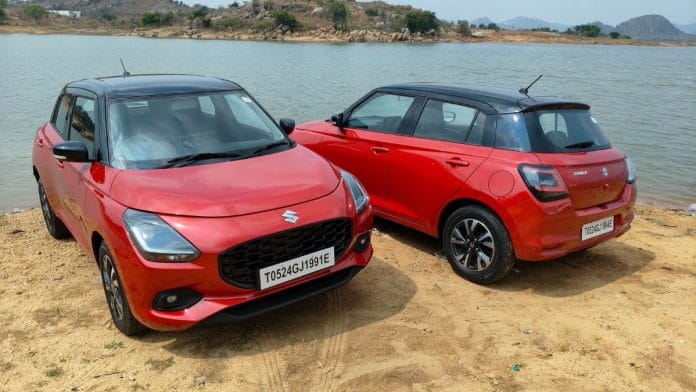In the next few days, you might see a headline that Maruti Suzuki’s Swift has sold a cumulative 3 million units since its launch in May 2005. That will be quite a feat for the hatchback, whose new version came out in May and raced to the top of the sales charts, despite not being available for the entire month, and in a country obsessed with sports utility vehicles.
Speaking from memory, two other car models in India would have crossed the 3 million milestone. The little Alto sold 4.5 million before its journey came to an end. Among those that continue, Wagon R has sold more than 3.2 million and continues to add to this tally with a larger, souped-up version. No other name comes to mind.
Speaking of Wagon R, I know a retired bureaucrat whose first car was a Maruti 800. He switched to Wagon R and has stayed with it, probably driving his third Wagon R now. He won’t have anything else. This gentleman is upright, ethical, and sharp. He is also safe and makes it a point to button the cuffs of his full-sleeve shirts, usually white. His Wagon R speed needle seldom nudges 70, that too only on expressways. You get the picture.
The Swift is a different animal, in behaviour and in perception. And it created a new market segment — premium hatchback — where prices were well above the entry level, where features mattered more than functionality, and where customers did not obsess over fuel efficiency or the colour white.
When it was first launched, the Swift did not come in white, although white was the overwhelming colour of India’s cars. Maruti’s designers believed the contours of the “hot hatch” did not deserve the obscurity of white. Its flagship colour was red.
The selling point of the Swift was style and performance. To give you a glimpse, the tachometer on a car’s dashboard, which measures the rotation speed of the engine, usually has the zero reading in the 8 o’clock position. In the Swift’s tachometer, zero was at 6 o’clock, which is where it is in high-performance cars for easy tracking by the driver’s eye.
Fuel economy has been the predominant discussion in India’s car showrooms. Maruti made television commercials focused on “petrol khatam hi nahi honda (it does not run out of petrol)” and “kitna deti hai (how fuel efficient is it?)”. But it did not position the Swift on the plank of fuel efficiency. According to a person who spent two decades with the company, there was a new programme, named Swift Energizer, to train dealer staff who would sell nothing but the Swift. And if they received a customer asking about its fuel economy, they were instructed to advise: “Aap please Wagon R dekh lijiye (why don’t you consider buying a Wagon R).”
(This led to insidious gossip in Delhi that the Swift’s fuel efficiency was so bad the company did not want to talk about it. That made Maruti change its stance.)
The Swift made a clean break from the design philosophy Maruti had followed till then (Maruti 800, Omni, Alto, Esteem, Wagon R….). There was the Zen before it, which had some curves, but the Swift was completely different. Inspired by the Hayabusa, Suzuki’s fabled sports motorcycle, it was meant to be a world car, and was sold in Europe as well.
Though it would be manufactured in different countries, its exterior and interior had to be the same. The Swift was to have one design and one drawing. But the Indian version came with a twist. It was modified to suit the conditions here (read potholes, dust, and heat). And thereby hangs a tale.
“We sent 30 engineers to Japan. It was the first time we were working concurrently with Suzuki. We worked on suspension, engine, seats, especially rear seat comfort,” C V Raman, who has been with Maruti since 1984 and has become synonymous with its engineering, told your columnist. “Whatever was specific to India, our engineers worked with Suzuki on it.”
In a little bit of a stunt, Maruti’s people mounted fibreglass body shells of the Swift at hoardings in many places. These shells did not have an engine, of course, but looked all too real and made people gawk.
The question still remained: “Will people pay the extra money for a small car?”
The answer came in the sales charts. Yes, the Alto and Wagon R sold more, but the Swift was the jewel in Maruti’s crown. The company re-aligned its Manesar factory to create more capacity for the hot hatch. It pulled out several newspaper ads because bookings were already high and its managing director at the time, Jagdish Khattar, said there was no need to spend money to get more customers.
Critical appreciation followed. The Indian Car of the Year award, which started in 2006, declared the Swift as the first ICOTY.
“All these things changed Maruti’s and Suzuki’s way of thinking. In the past, the Japan models were sold all over. From 2002 onwards, working together with Suzuki started,” said Mr Raman.
A little later, Maruti phased out the Esteem, a popular sedan of its time, because it looked jaded in comparison. However, Suzuki did not have a sedan between its hatchbacks and the larger sedan, SX4.
Then inspiration struck. Maruti’s research and design decided to fashion a sedan out of the Swift. With support from Japan, the team started the work from scratch, from the clay-model stage. The outcome, Swift Dzire, went on to become ubiquitous. It has clocked 2.5 million in sales, and you might, in a non-too-distant future, see headlines that the DZire has done 3 million as well.
Suveen Sinha @suveensinha is a journalist at Business Standard. Views are personal.






